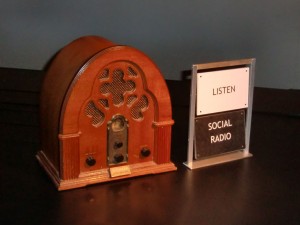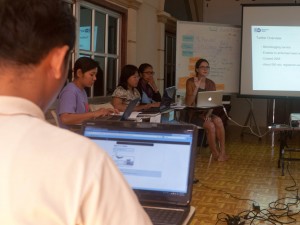Making broadcasting more social

photo: flickr/Affiliate
For too many broadcasters, social media still remains something of an afterthought. A producer might promote an upcoming program on the Facebook page or send out a tweet. But really, much more can and should be done. These days, social media needs to be part of the entire broadcast production process.
 There are broadcasters out there who are really taking advantage of social media, and using it in innovative ways. Al Jazeera English, for example, has a program called The Stream that explores the potential of social media to disseminate news. The show brings together online sources and discussions while looking for new voices and perspectives traditional media might miss.
There are broadcasters out there who are really taking advantage of social media, and using it in innovative ways. Al Jazeera English, for example, has a program called The Stream that explores the potential of social media to disseminate news. The show brings together online sources and discussions while looking for new voices and perspectives traditional media might miss.
NPR, the public radio network in the United States, has not only posted especially good stories that were broadcast on the radio on their Facebook and Twitter feeds, they are also soliciting content from listeners. This Fall, they put out a call to Americans living outside the US to tell NPR how they planned on celebrating the holiday of Thanksgiving. In another series, called Project Expat, the station asked for comments and stories from expats and even called on them to record sounds from their home away from home. Expat experiences were played on the radio and pictures and text stories went on the NPR website.
While cool broadcasting/social media link-ups are happening, many stations aren’t exploiting the full potential. Maybe they still think of Facebook as a place for talking about what you had for breakfast. More likely, they don’t think they have the staff or the time to add another task to their already packed days.

photo: flickr/@notnixon
But stations that neglect social media run the risk of losing relevance, and losing their audiences. And these stations are also bypassing an incredibly useful tool that can add a great deal of value to their broadcast content and general news operation.
The BBC jumped head first into online journalism early on and has since made a commitment to social media. In fact, last October, the BBC announced it had signed a new partnership with Twitter Amplify, a video promotion tool. It’s the first partnership between Amplify and a global broadcaster.
The BBC has said it feels social media has three highly valuable journalistic roles:
- a platform for content – it’s a way of getting its journalism out there, in short form or as a tool to take people to their journalism on the BBC website, TV or radio networks. It engages different and younger audiences
- newsgathering – it helps reporters gather more, and sometimes better, material and find a range of voices, ideas and eyewitnesses quickly.
- audience engagement – allows better listening to and talking with the audience, and allows the BBC to speak to different groups.
So what is your media outlet waiting for?
Boosting the social component
DW Akademie recently held a workshop at the Women’s Media Centre (WMC), a radio station and television production organization based in Phnom Penh, Cambodia. The goal was to help producers and editors understand the importance of social media and how they might use it effectively.
It’s a fascinating time for social media in Cambodia. While Facebook arrived in Cambodia in 2008, it was mostly used to flirt and share funny pictures. But around 2010, people, young people mostly, began using it to share information about societal problems, like a daytime robbery, a hit-and-run traffic accident, even illegal logging. But its use really exploded in 2013 during controversial national elections. In a country where most of the media faithfully toes the government line, Facebook became an outlet for free expression. And young people showed they weren’t afraid to speak up, or at least post their thoughts on political events. It was a first.
In the WMC workshop, while everyone knew about Facebook, YouTube and general posting, they didn’t really understand how to use the platforms well. Others, like Twitter, Soundcloud, etc., were unknown.
My co-trainer and I stressed the need to incorporate social media into all parts of the production process to add value to the broadcasts and start conversations – between the station and the audience and among audience members themselves.
Because these days, the best advertising is through word of mouth from friends, not from ads. And if friends are talking about something interesting on the WMC Facebook site, that’s the best way to get others to tune in to the radio program or TV series.
Here’s a quick breakdown of some of the ways the workshop participants came up with for integrating social media into the entire production process, using it for research, distribution and collaboration.
Pre-production
Find experts, ask your audience what topics they want covered and for specific questions, or to share their experiences around a certain issue. Announce the upcoming show, then feature profiles of guests or even short clips if you have them.
Production
Link social media feeds to the station website during the live feed. Post pictures from the studio during the show and accept questions live from your audience to ask your guest. Tweet the most interesting answers from your guests, making something of a highlight feed.
Post-Production
Post the audio/video and edited versions on your social media platforms. Think about producing a behind-the-scenes gallery or video or profile one of your presenters – build up a personal connection with your audience. Get their feedback on what they liked and didn’t about the show, and respond to it. This also serves as useful research to make your content even better next time around.
After the five days of the workshop (which sped by like greased lightning), WMC staff said they were no longer going to leave all the social media responsibilities in the hands of one outside contractor. Staying active on Facebook, YouTube and other platforms were going to simply become part of everyone’s job description.
A smart move.
“Social media can’t belong to one person. It needs to be part of everyone’s job. It has to be integrated into the existing editorial process and production process.”
–-Jennifer Preston, former social media editor at The New York Times
Author: Kyle James






Feedback